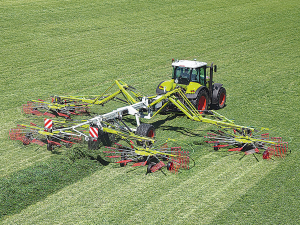Forage harvester maker Claas is celebrating 20 years of its Liner four-rotor swather.
In 1999 Claas was making an integrated range of mowers, conditioners, rakes, balers, forage wagons and forage harvesters. But the company was missing a high output rake capable of staying ahead of its ‘hungry’ Jaguar self-propelled harvester.
With a working width of up to 12.5m Liner 3000 had twice the productivity of the two-rotor swathers, so increasing the capacity of the entire Claas harvesting chain.
Farmers and contractors reported up to 30% higher productivity thanks to faster chopping rates and less downtime.
Today, four-rotor swathers are the norm in high output operations and the Liner series continues evolving to meet shorter harvest windows and a wider range of crops.
The Liner 4000 and 3600 models come in maximum working widths from 9.9 to 15.5 m and swathing widths from 1.2 to 2.6 m. These machines adapt easily to different forage materials and all commonly used pick-ups, Claas says.
The silage tines developed by Claas combine with accurate rotor movement control to achieve clean and complete crop pick-up while protecting the ground beneath.
All models have hermetically sealed, maintenance free rotor domes that continuously lubricate cam rollers in an oil bath.
Integrated tine arms are fitted with the maker’s patented Profix tine arm attachment system, allowing tine arms to be replaced in the field with minimal effort. In use, predefined bending points are located outside the rotor dome, so protecting the internal components and minimising maintenance.
The large diameter and gradual rise of the cast iron cam track ensure smooth running tine arms and clean raking, and the smooth movement of the cam rollers is said to markedly increase the components’ service life.
Despite their operating widths both models fold to compact dimensions for safe road transport at speeds of up to 50km/h. Tine arms need not be removed for transport. – Mark Daniel











